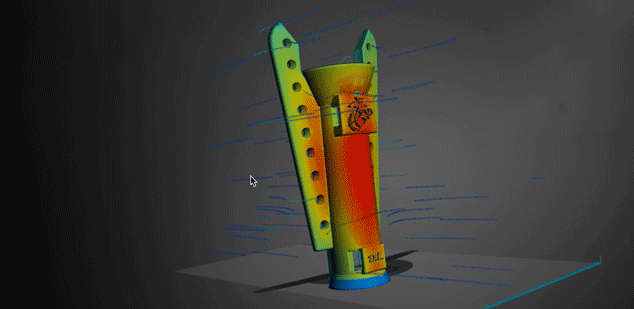Northwell Health, a not for profit healthcare organization in New York, announced a new study to manufacture and commercialize ‘The FIN’, an amphibious 3D printed prosthetic leg.
The FIN was created by Northwell Health in collaboration with The Feinstein Institute for Medical Research (New York) and Eschen Prosthetic and Orthotics, a New York-based provider of prosthetic services.
The prosthetic leg, made from carbon fiber enhanced nylon and 3D printed using 3HTI/Markforged’s printing technology, is compatible with land and water. This means that the FIN wearer can freely move in and out of the water without having to switch their prosthetic leg. Todd Goldstein, Prosthetic Designer at Northwell Health stated:
“My hope is that this device creates unforeseen opportunities for amputees everywhere. This study is the first step in making this innovative prosthetic available to the millions of amputees looking to return to the water.”
For the study, 10 participants will provide data regarding underwater use and efficiency of the FIN.
3D printed amphibious prosthetic
The FIN has cone-shaped holes on the sides. These holes let wearers of the prosthetic manage the speed of propulsion by controlling the amount of water passing through the prosthetic. To make the prosthetic person-specific, the holes can be narrowed or widened.

Product feedback from two participants involved in the study was released by Northwell Health. One of the participants, Seamus Doherty from New York, said, “this prosthetic is the answer to my prayers in being able to spend more time with Seamus [Doherty’s son] at the beach and truly being free to come and go in and out of the water.”
Northwell Health hopes that the success of its project will lead to a partnership with the U.S. Department of Veterans Affairs to make the prosthetic easily available to the general public and the veterans in particular.
3D printed hope for amputees
The study Estimating the Prevalence of Limb Loss in the United States: 2005 to 2050 published in Archives of Physical Medicine and Rehabilitation journal, showed that in 2005 there were approximately 1.6 million people living with the loss of a limb in the U.S alone. It was projected in the study that by 2050 the number will reach 3.6 million.
In recent years, 3D printing technology has provided a lot of hope to amputees around the world. An open source prosthetic organization, e-NABLE, visited Haiti to provide 3D printed limbs for children who lost their limbs in conflicts and natural disasters.
Prior to this, PSYONIC, a company specializing in bio-integrated technologies, also began operating prosthetic clinics in developing countries such as Ecuador, Guatemala, and Mexico. The first clinical tests of the company’s 3D printed bionic hand was carried out in Ecuador.
Furthermore, in 2017, Ben Ryan, the founder of the Ambionics project, designed a 3D printed prosthetic arm for his son at a cost significantly lower than prosthetics available on the market.
To stay on top of news related to 3D printing, subscribe to our 3D printing newsletter, and join us on Facebook and Twitter.
Looking for jobs? Our 3D printing job site is the place to look.
Featured image shows a Fin wearer standing underwater. Photo via Northwell Health


